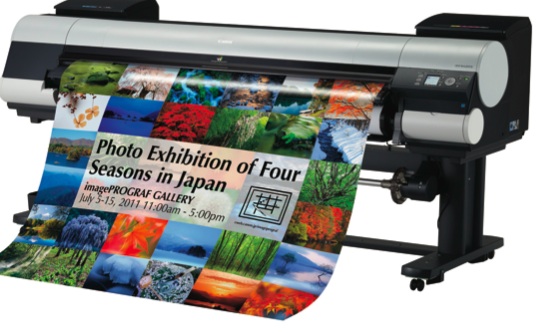Nessan Cleary takes a closer look at a model which is of five new ImagePrograf machines.
Canon has recently added five more wide-format printers to its ImagePrograf range of high quality aqueous inkjet printers. Amongst these is the 1524mm wide iPF 9400S which, as with all the ‘S’ series models, is aimed at a production environment.
Canon has managed to boost the speed over the older 9000S by around 150% giving it a fairly fast maximum throughput of 36m2/hr. Canon was a little coy about how it has achieved this, but it appears to be down to altering the firing frequency of the heads, which has reduced the number of passes without losing any print quality.
Most of the iPrograf range have 12 colour inksets and are aimed at the photo printing market, but the eight colour inkset of the 9400S is designed to be faster and more economical.
Marketing manager Wilko Van Oostrum says: “You can choose eco print mode so you can print without the light inks and make a cost saving of 50%. The print output will not be as brilliant as when you use the light colours but it’s enough for some applications.”
It uses the same Canon thermal printhead as the previous model with a resolution of 2400 x 1200dpi. There are two heads, each having six channels. This means that there are double the number of channels available for the cyan, light cyan, light magenta and grey, than for the magenta, yellow, black and light black colours.
This new series also use the same Canon Lucia EX inks as the older models. However, the cartridges have a different chip so that the new inks can be used in older machines, but not vice versa. Van Oostrum says this is to prevent regional grey market imports. This of course also makes life difficult for third party ink suppliers. The same inks are now used right across the iPrograf range, with the same profiles so that prints from these machines are indistinguishable from each other.
One of the unique features of this 04 series is the calibration link between the 24ins iPF6450 and the other printers. This model comes with an embedded spectrophotometer, which makes profiles that can then be shared with the other iPrograf models on the network, guaranteeing uniform colours between all the printers and making it much easier to manage a fleet of these machines from a central point. Of course, you do have to have a 6450 to do this, but Van Oostrum points out that it’s inconceivable not to have a spectrophotometer in a production environment for calibrating individual printers anyway.
However, the profiles generated through the calibration link are not standard ICC profiles. But X-Rite has provided a tool that customers can download to convert the Canon profiles into standard ICC profiles.
Canon has already introduced the option of a click charge and this continues in this series. Van Oostrum points out that office copiers all levy click charges to pay for maintenance and consumables. Then again, most printshop owners hate click charges so it’s hard to see too many customers taking this option.
It comes supplied with Canon’s Poster Artist Rip, which also contains a lot of copyright free images and templates to help customers put posters and so on together easily. There's also a media profile tool so that users only need to download profiles for the papers that they are using. It covers most standard paper types as well as Canon’s own. Canon has also fitted a larger hard drive and beefed up the networking card.
The print driver includes a calculation tool that measures the amount of ink and paper used so that users can now get a report back detailing exactly how much each job has cost. Users can supply their own information, such as the cost of each paper, labour costs and so on to get a fairly accurate cost report back in the form of a CVS file, which could then be imported into an accounts or invoicing package to track the profit margins on each job. It’s a useful feature, one that is sometimes found on high end Rip and workflow programs and which is bound to become more widespread.
Canon has sometimes struggled to make an impact on this market against the competing Epson and HP models. Yet the iPrograf printers have been solid performers for some years now and the improvements to this latest series should attract more attention.


